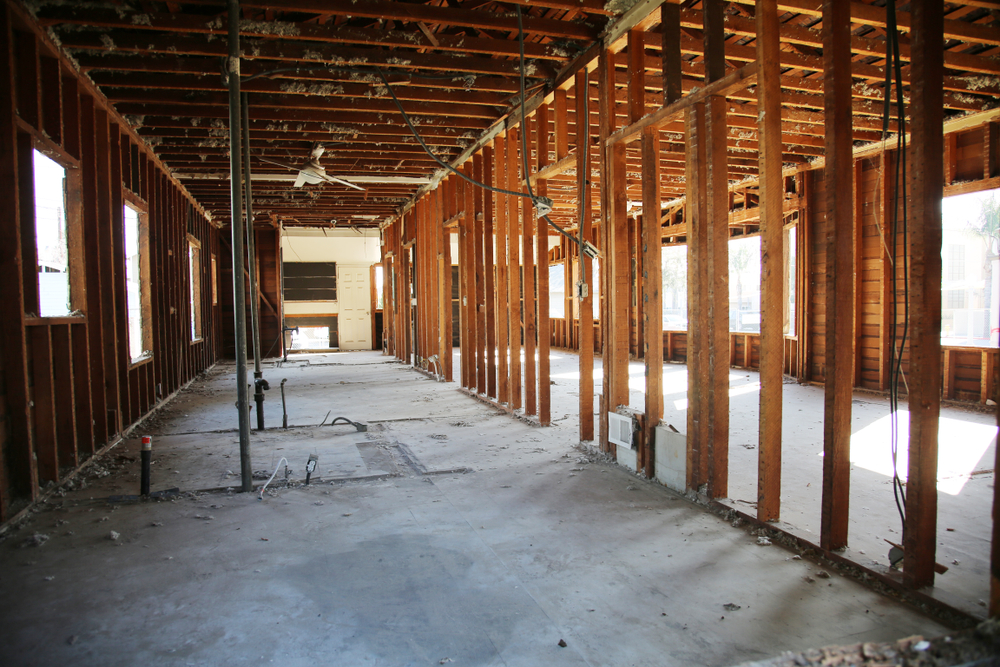Renovating an older commercial building isn’t just about adding something new— it’s about removing what no longer belongs.
Behind plaster walls and drop ceilings, you’ll likely find outdated wiring, hazardous materials, and decades of patchwork repairs that can make upgrades dangerous and inefficient.
That’s why interior demolition is the first step toward any successful modernization.
For commercial property owners across Cincinnati, Kentucky, and the greater Midwest, Environmental Demolition Group’s interior demolition is the smart, compliant way to stabilize, clean, and prepare a structure for the future. It’s not about destruction; it’s about transformation.

What Is Interior Demolition?
Interior demolition (sometimes called building strip-out) focuses on the careful removal of non-structural materials inside a commercial building. The goal is to clear space for remodeling or upgrades without disturbing the exterior or load-bearing framework.
Depending on the scope, this work can include removing:
- Walls, ceilings, and flooring
- HVAC, electrical, and plumbing components
- Fixtures, insulation, and finishes
- Outdated or contaminated materials
These strip-out services are a specialized form of selective demolition, not full demolition, because the building’s core structure remains intact. The result is a clean, code-ready canvas for architects and contractors.
Why Older Commercial Buildings Need Interior Demolition
Every aging building carries hidden challenges, and ignoring them can lead to serious safety risks, compliance issues, or project delays.
1. Identifying and Removing Hazardous Materials
Older buildings often contain hazardous materials, such as lead paint, asbestos, and mold, that modern codes now prohibit.
These hazards must be identified and removed by certified professionals. EDG’s interior demolition crews isolate, extract, and dispose of contaminants in compliance with EPA and OSHA regulations— keeping your building safe for every person who enters it.
2. Preparing for Structural Improvements
Interior demolition clears the way for reinforcements, new layouts, and modern utilities.
Whether it’s rerouting power lines or upgrading mechanical systems, EDG’s selective removal ensures every modification happens safely, within design limits, and with minimal downtime.
3. Supporting Code-Compliant Renovations
Many older buildings were constructed long before today’s safety and energy standards were in place. Interior demolition enables the installation of insulation, energy-efficient systems, and modern ventilation that comply with ASHRAE and local building codes.
4. Making Adaptive Reuse Possible
Turning warehouses into offices or historic properties into retail hubs requires reparation. Interior demolition removes unsafe materials while protecting architectural elements.
Sustainability Starts With Smart Removal
EDG’s certified team integrates sustainability into every demolition phase:
- Recycling: Salvaging reusable metal, concrete, and wood
- Dust control: Using containment and HEPA filtration
- Regulated disposal: Following EPA and state environmental laws
- Reduced landfill waste: Minimizing impact through efficient sorting
This approach lowers environmental impact and improves long-term efficiency for both the site and the surrounding community.

The EDG Interior Demolition Process
Every project is built on safety, clear communication, and attention to detail. Our proven process ensures consistency and control from the first inspection to final clearance:
- Site Assessment & Engineering Survey
We begin with a detailed inspection to identify hazards, load-bearing elements, and utilities, in accordance with OSHA’s Demolition Standard (29 CFR 1926 Subpart T).
- Containment & Air Control
Barriers, negative air systems, and HEPA filtration work together to maintain air quality and protect occupied areas.
- Selective Removal
Certified crews remove targeted components, from walls and flooring to MEP systems, while preserving structural integrity.
- Waste Management & Recycling
Materials are sorted, logged, and hauled in accordance with state environmental regulations.
- Verification & Clearance
Post-demo inspections and air testing confirm the space is ready for reconstruction or renovation.
Selective vs. Full Demolition
Not every project needs a complete teardown. Interior demolition is a part of selective demolition, targeting only the areas that need to be changed.
Type | Scope | Best Use |
Full Demolition | Entire structure | Unsafe/condemned buildings |
Selective Demolition | Specific sections | Remodels, expansions, adaptive reuse |
Interior Demolition | Non-structural interiors | Modernizing older buildings |
This approach saves time, reduces costs, and preserves the structural and historic character—especially for historic and high-value properties.

Why Experience Matters
Interior demolition involves more than just power tools—it takes foresight and expertise. A single missed hazard or live conduit can derail progress and put workers at risk.
With over 20 years of experience in selective demolition, hazardous material abatement, and environmental cleanup, EDG delivers reliable, code-ready results.
We specialize in:
- Occupied and operational facilities
- Historic property preservation
- Complex load-bearing modifications (with engineering oversight)
- Complete documentation and compliance reporting
When compliance, control, and craftsmanship matter, EDG is the trusted partner for selective and interior demolition.
Serving Cincinnati, Kentucky, and the Midwest
From downtown office towers to industrial facilities and healthcare campuses, we provide interior demolition tailored to each project’s requirements.
Our regional teams understand local permitting, inspection, and disposal regulations, ensuring that every project runs smoothly from planning to completion.
Frequently Asked Questions
Not exactly. Selective demolition is a broader term that includes both interior and exterior removal.
Interior demolition focuses solely on non-structural areas inside the building while preserving the main structure for reuse or renovation.
Older buildings often conceal hazardous materials, such as asbestos, lead paint, or outdated wiring, which fail to meet modern safety codes.
Interior demolition removes those hazards safely and prepares the space for upgrades that meet current safety and energy standards.
Timelines vary based on size, complexity, and materials involved. Smaller projects may take a few days, while large-scale commercial interiors can take several weeks to complete. EDG works efficiently to minimize downtime and keep renovation schedules on track.
Yes, when performed by certified professionals. EDG uses containment systems, negative air pressure, and dust control measures to isolate work zones and protect employees, tenants, and visitors during demolition.
EDG sorts, documents, and disposes of all debris in a responsible manner. Recyclable materials are salvaged, while hazardous materials are handled in compliance with EPA and state environmental regulations.
Partner With the Team That Gets It Right
Interior demolition isn’t the end of a building’s story— it’s the beginning of its next one. By removing outdated materials safely and efficiently, EDG helps older properties evolve without losing their integrity.
Contact us at 859-363-4863 or request a free quote to plan a compliant, low-disruption interior demolition today!




